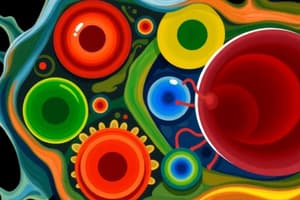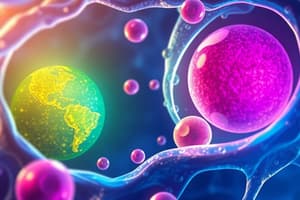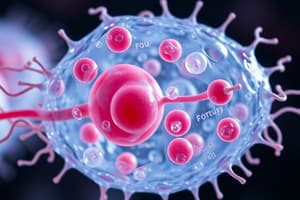Podcast
Questions and Answers
What is the function of mitochondria?
What is the function of mitochondria?
- Regulate cell functions/Store DNA
- Regulate movement of materials into/out of cell
- Protein synthesis
- Cell respiration (produce ATP) (correct)
Which organelle synthesizes proteins by translating mRNA into amino acid sequences?
Which organelle synthesizes proteins by translating mRNA into amino acid sequences?
- Mitochondria
- Ribosome (correct)
- Cell membrane
- Nucleus
What is the energy stored in carbohydrates released as through the process of respiration?
What is the energy stored in carbohydrates released as through the process of respiration?
- Additional Energy for Growth
- Energy Use by Living Organisms
- Energy Stored in Food
- Energy Available for Living Organisms (correct)
Which two processes are required to cycle oxygen and carbon dioxide through an ecosystem?
Which two processes are required to cycle oxygen and carbon dioxide through an ecosystem?
What does insulin do in the body to maintain homeostasis?
What does insulin do in the body to maintain homeostasis?
What do vaccines contain to stimulate the immune system?
What do vaccines contain to stimulate the immune system?
What would happen if mitochondria were removed from a cell?
What would happen if mitochondria were removed from a cell?
Which organelle regulates the movement of materials into and out of the cell?
Which organelle regulates the movement of materials into and out of the cell?
What is the primary function of ribosomes within a cell?
What is the primary function of ribosomes within a cell?
What is the role of the pancreas in the feedback mechanism shown in the diagram for maintaining homeostasis?
What is the role of the pancreas in the feedback mechanism shown in the diagram for maintaining homeostasis?
Flashcards are hidden until you start studying
Study Notes
Cell Structure and Function
- Cell membrane regulates the movement of materials into and out of the cell
- Nucleus stores DNA and regulates cell functions
- Mitochondria is the site of cell respiration, producing ATP
- Ribosome synthesizes proteins by translating mRNA into a specific amino acid sequence
Cellular Respiration
- Energy stored in carbohydrates is released as ATP through the process of respiration
- Mitochondria is responsible for cell respiration, producing ATP
Oxygen and Carbon Dioxide Cycling
- Photosynthesis and respiration are the processes that cycle oxygen and carbon dioxide through ecosystems
- Concentrations of oxygen and carbon dioxide fluctuate throughout the day in aquatic ecosystems
Homeostasis
- Feedback mechanisms are used by the body to maintain homeostasis
- Insulin, released by the pancreas, lowers blood sugar levels back to normal
Immunity and Vaccines
- Vaccines contain dead or weakened pathogens that stimulate the immune system to produce antibodies
- Antibodies can be produced in the future to prevent infections and develop immunity
Studying That Suits You
Use AI to generate personalized quizzes and flashcards to suit your learning preferences.





